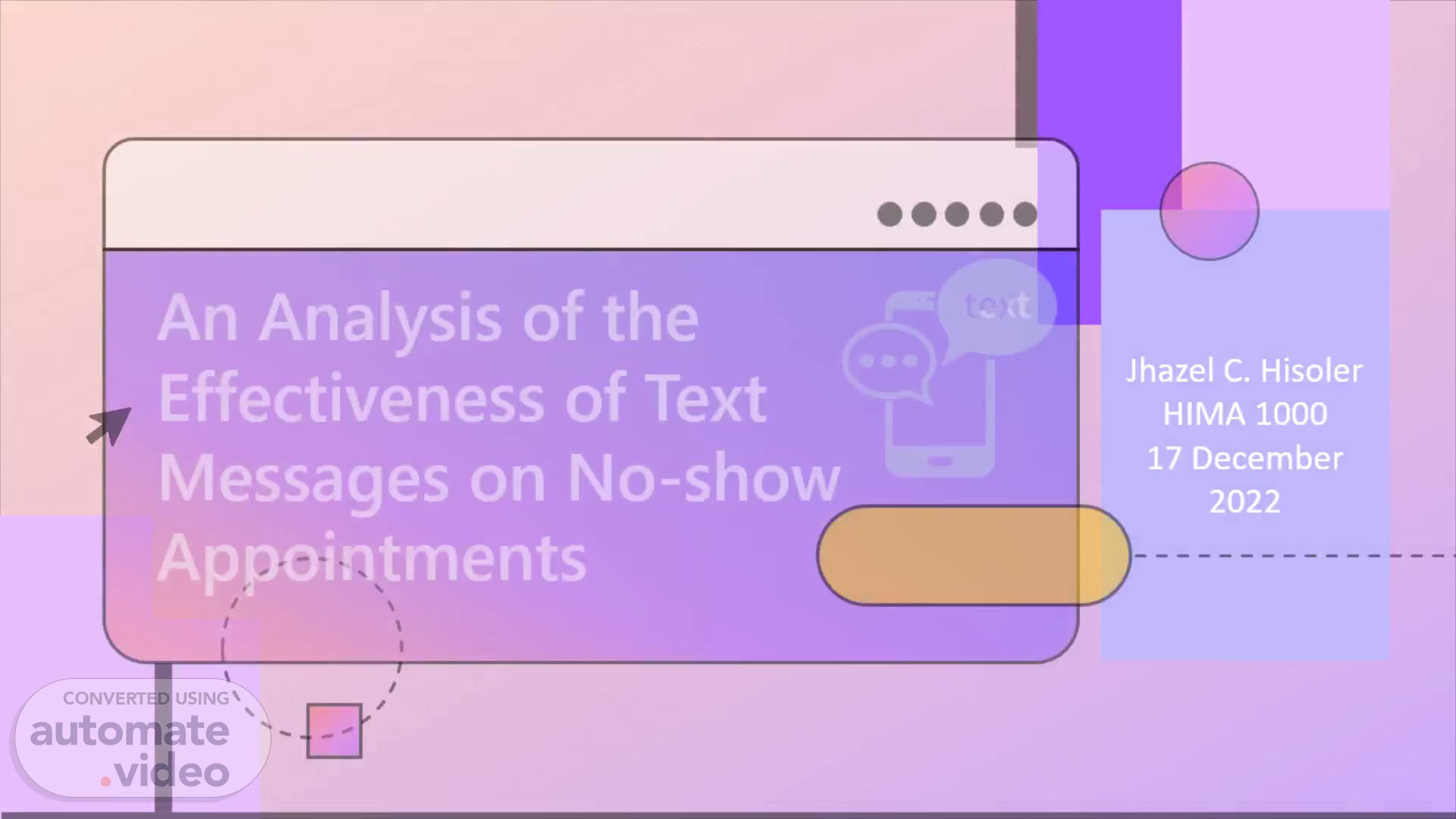
Page 1 (0s)
[Audio] An analysis of the effectiveness of text messages on no-show appointments..
Page 2 (7s)
[Audio] Contents. Background, Methodology, Possible Causes, The Dataset & Potential Users, Data presentation & analysis, Further Research, Hypothesis and Conclusions..
Page 3 (24s)
Background. 3. Primary care practitioners had been provided with access to text message reminder applications..
Page 4 (53s)
What information are we using?. Line graph and numbers.
Page 5 (1m 22s)
Potential Users. 5. Government Agencies. Maple Leaf with solid fill.
Page 6 (1m 36s)
Sending an SMS notification should reduce the number of missed appointments at Primary Care Practitioners..
Page 7 (1m 48s)
[Audio] The first step taken in my methodology was to examine the data in Microsoft Excel and cross referenced all data to the patients ID number. I removed all unnecessary columns and created pivot tables for comparison. Afterwards, the data was imported into Microsoft Power BI for visualization. Clustered Bar charts, pie charts and tables were created to present the data. Finally, trends were identified and compared to my hypothesis..
Page 8 (2m 25s)
[Audio] The next section of this presentation will focus on the data itself and how it was analyzed..
Page 9 (2m 35s)
[Audio] The source data is presented graphically using the column chart. In the upper right-hand table, the data is converted to percentages so that those that did not get the text can be compared to those that did. The pie charts demonstrate that the rate of no-shows actually increases with SMS notification..
Page 10 (3m 0s)
[Audio] This slide graphically shows the rate of non-attendance by age according to whether or not an SMS notification was sent. The rate of no-shows increases for all age ranges with SMS notification. The rate of no-shows is actually higher for those in the 0– 60-year-old range..
Page 11 (3m 22s)
[Audio] Here we plot the rate of no-shows with or without SMS notification against gender. Although the rate of no-shows increases when SMS notifications are sent, the data would suggest that gender has little to do with the rate of no-shows..
Page 12 (3m 44s)
[Audio] On this slide, we plot health issues versus whether the appointment was a no-show. On the left, we chart for patients that did not receive an SMS notification, while on the right, we show patients with SMS notification. In the legend on these charts, a NO demonstrates that a patient was not a "no-show", while a YES indicates a "no-show". There's no appreciable difference due to hypertension or diabetes, however, for substance abusers, the rate of no-shows actually doubles for those that received an SMS notification..
Page 13 (4m 24s)
[Audio] Here we study the effect that education level has on whether an appointment is a show or no-show after receiving an SMS notification. The patients with just a high school education or equivalent seem to have a slightly higher increase in the rate of non-attendance when given a text notification. The average difference across the board is about 10%, but for those with only high school education, it is up 14%..
Page 14 (4m 55s)
[Audio] Lastly, in this slide, we see that poverty level appears to be a factor in whether or not the patient is a no-show to their appointment after being sent an SMS notification. For those above the poverty line, the rate of no shows jumped from 16% to 27%. For those below the poverty line, the rate of increase in no-shows went from 19% to 34%, a 15% increase..
Page 15 (5m 25s)
Conclusions. Checkmark.
Page 16 (5m 30s)
[Audio] Our hypothesis says that sending an SMS Notification should reduce the number of missed appointments at Primary Care Practitioners. However, the results suggest that SMS Notification did not reduce the rate of no-shows..
Page 17 (5m 48s)
Possible Causes. SMS Notifications result in an average 11% increase in the rate of No-Shows. Some populations have a higher change in the rate of No-Shows following an SMS Notification..
Page 18 (6m 17s)
Further Research. It could be worthwhile to determine if there are not more factors causing the increase in no-shows after sending an SMS notification. The data presented may not show the full picture..
Page 19 (6m 34s)
Recommendations. Take steps to overcome any potential obstacles that may prevent one from receiving health appointment reminders via text message. Improve the use of the SMS reminder service for the identified vulnerable groups..
Page 20 (6m 53s)
SLC Primary Care Group (2016). EMR Demographics [Data set]. St. Lawrence College, Kingston. SLC HealthTech (2016). Text Message Reminder System Data [Data set]. St. Lawrence College, Kingston. SLC Primary Care Group (2016). EMR Clinica Data [Data set]. St. Lawrence College, Kingston..
Page 21 (7m 11s)
THANK YOU!. 21. Team. Cursor with solid fill. Cursor with solid fill.